Caring for
Ducklings and Goslings
It Takes Two
It is always best to start with at least two
ducklings/goslings. They are flock animals and thrive in their own
company. Starting with more than two should be done with extreme
caution. Many places will only sell a half dozen ducklings at a time
and many will only sell straight-run (gender unconfirmed--you get
what you get), and this can lead to behavioral issues down the road.
Once grown, adult ducks do best with a 1 drake
for every 3-4 hens. Separations tend to become inevitable to
ensure safety in a flock that isn't correctly balanced.
Too many drakes results in over-mating and can
lead to serious reproductive disorders among hens. It can also lead
to excessive fighting among the boys during the spring & summer.
Don't be fooled by good behavior among newly hatched boys, they
often become overzealous once they mature and encounter their
first spring.
Healthy ratios of males to females and not
taking on more than you can ultimately handle is the key to flock
success and human happiness.
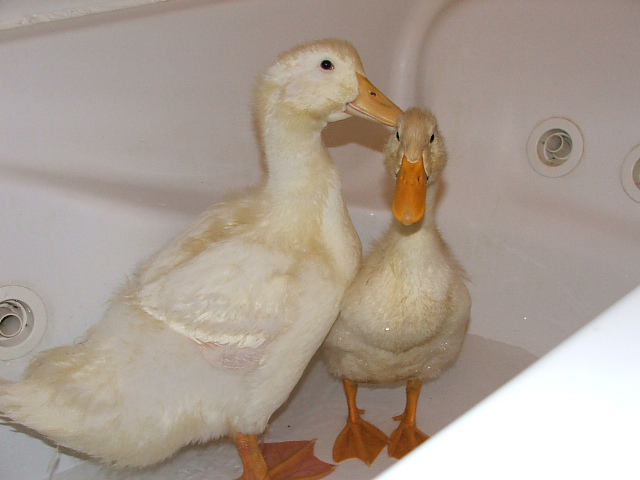
Lilly & Piper in the tub
Draft-free Housing
Ducklings and goslings need their safe house
set up somewhere inside that is draft-free.
Aquariums are not a good option for baby
waterfowl because they do not allow proper ventilation.
Do not put waterfowl into cages with wire
bottoms. Waterfowl
need soft bedding or grass under foot in order to avoid serious foot
injuries (bumblefoot).
House Size
Our duckling house measures approximately 2'
Wide x 3' Long x 1.5' High and is raised about 3' off the ground. It can house two ducklings for about 4-5
weeks. Then it will be time to move them to a larger pen.
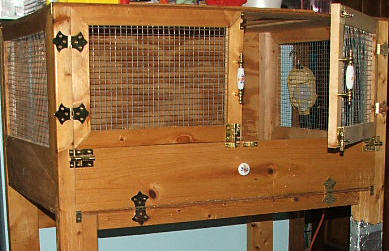
Pine Shavings
We use pine shavings (never cedar) for ducklings 6 weeks old
and under. It will become evident when the shavings no longer keep
up with your duckling or gosling's poop. At this time, we replace
the shavings with mulched hay. Most hay suppliers have this leftover
hay and even sell it at a better price than their regular bails.
Avoid newspaper, which removes precious oils
from your hatchling's feathers. Towels are also not a great idea for
bedding since loose strings can tangle in toenails or be ingested.
Heat Source
Young ducklings goslings need a heat source.
Heat lamps are ideal in cooler situations. Be careful not to
overheat your ducklings during the summer or on hot days.
A heat lamp is not necessarily needed in warmer
& draft free conditions. In warmer situations, you can utilize a
regular light bulb to provide warmth for your hatchlings. Just hook
them outside of your duckling/gosling house.
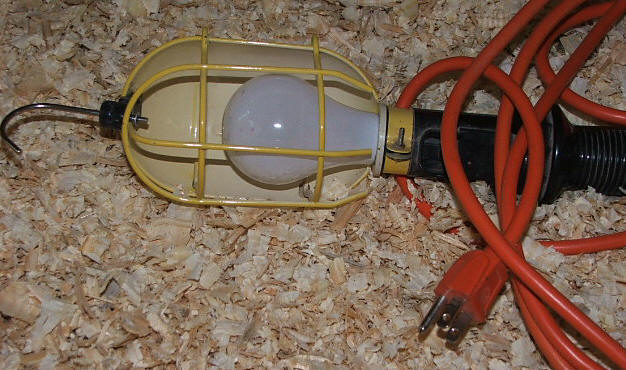
Remember the heat source must be situated
outside of the duckling/gosling pen.
Feather Dusters & Woobies
One of our favorite tricks is to hang a feather
duster inside of our "Ling House." We leave space enough underneath
for the ducklings/goslings to cuddle under. This mimicks a mothers
underside and makes a nice, cozy spot for babies to cuddle.
Your heat source/light should be near the feather duster, but be
careful to avoid a fire hazard.
Lil Bo Peep lost her sibling when she came to
us. Her rescuers put a plush duckling in her house with her as a
surrogate sibling.
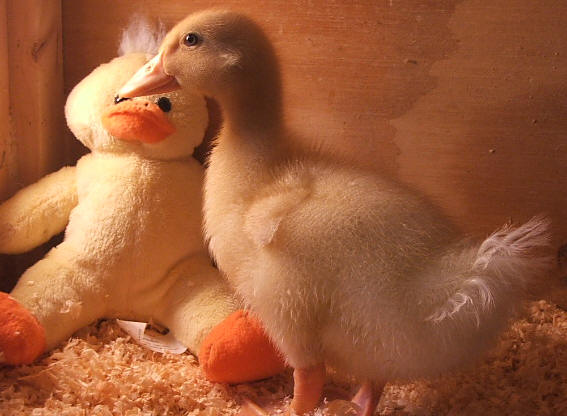
Food
We highly recommend Mazuri Waterfowl Starter.
It is a great blend to get your duckling or gosling off to the best
start. Mazuri has a dealer locator on their website, or you can have
a bag shipped directly to you. We put their food in weighted feed
dishes to prevent spilling. Food should be available 24/7.
Drinking Water
Ducklings and goslings need fresh drinking
water. Grain stores sell small plastic water founts for ducklings
and goslings. Small bowls are not recommended because ducklings can
stumble in and out of them, which may lead to serious leg injuries.
Bathing
Ducklings and goslings loved to swim! When
beginning this activity with your little ones, start by first
filling your sink or tub so that the water line only comes to the
top of your bird's legs. Let them splash around to ensure that
their feathers are properly oiled. Sometimes newly hatched birds
will not be quite waterproof yet. If so, you don't want to fill the
tub any higher yet. Let them splash around in this level of water.
Add duckling food to the water to get them foraging and playing. If
your duckling or gosling is waterproof, you can continue to fill the
tub a little higher. Stop filling when their webbed feet can no
longer touch the bottom. Give them a couple minutes to swim and then
begin draining. You want to increase swim times slowly. Initial
swims should be brief.
Never put ducklings or goslings straight onto a
pond. Small birds do not necessarily know how to get in and out of
water or forage for food on their own. Baby birds that become
trapped on water or are too afraid to leave often get chilled,
succumb to pneumonia and do not survive. They are also extremely
prone to predatory attacks of every kind, ranging from snapping
turtle to hawks.
Panting
Panting is a sign that your duckling/gosling is
either too hot in its environment or it can be an early sign of
illness.
Abdominal heaving is a sign that your
duckling/gosling needs immediate vet attention and most likely
antibiotics. Abdominal heaving is sometimes accompanied by tail
pumping and panting.

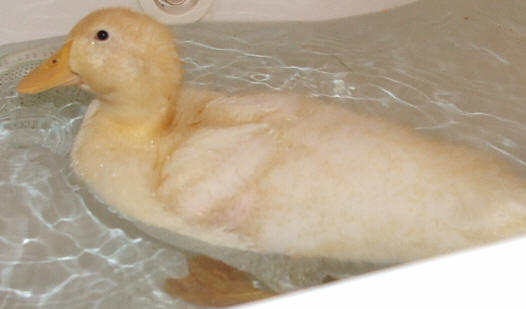
Fever & Medication
Hot legs and a hot bill are a sign of fever.
Antibiotics will be required immediately. Vets commonly prescribe
Amoxi Drops for birds under 4 pounds and Baytril for birds over 4
lbs.
The tricky thing about medicating ducklings and
goslings is their rapid growth rate. You will need to weigh your
duckling/gosling every day and your vet will need to
give you a dosing chart that tells you how much medicine to
administer as your hatchling grows.
Fever is the body's means of fighting
infection. Cool baths should be used with discretion. Always ask
your vet for advice. It is vital to keep your
duckling/gosling eating and drinking. Swimming activities are often
a means to this end. Lings that won't eat or drink will often
do so in a tub filled with an inch or two of water. Just sprinkle
their food in the water while they're swimming.
Transitioning From Inside to Outside
Moving your ducklings/goslings from indoors to
outdoors can be very stressful on both you and your baby birds. We
do not move our sanctuary babies permanently outdoors until they are
at least 6 weeks old.
We bring our rescued hatchlings outdoors
when they are about 2 weeks of age and only in positive weather
conditions. Outdoor excursions begin for 15-20 minutes a day for a 2
week old duckling and grow to an hour or two a day during their
3-4th weeks of age. By their 5-6 weeks of age, they are spending
daylight hours outside on good weather days (again, avoiding extreme
heat, cold or heavy rain). They are brought back inside at night.
If a thunderstorm comes and you have young
ducklings/goslings outside, you will need to teach them to go into
their house until the storm is over. Just close them in during the
storm and reopen their house when it stops. Avoid leaving baby
animals out in the rain. They can become saturated and become ill.
Thank you,
Damiana and Alice!
Special thanks to Damiana and Alice yet
again for running a successful flower bulb fundraiser to benefit
the ducks and geese here at Majestic. It was great seeing you
again! And as always, we thank you for thinking of us and all of
your support!

